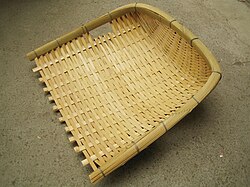A winnowing basket or fan is a tool for winnowing grain from chaff while removing dirt and dust too.[1] They have been used traditionally in a number of civilizations for centuries,[2] and are still in use today in some countries.

Use
editUnprocessed grain, mixed with impurities like dirt or inedible husks, is placed on the basket. The basket is then lifted and shaken, which separates out lighter particles (usually inedible husks) from heavier particles (the grain). The process can benefit from mild wind, which can carry away lighter particles.[1][3]
By region
editAncient Greece
editThe λικνον (liknon) appears in the Iliad (5.4999).[4]
India
editThese have been used in India from centuries and still see widespread contemporary use. They are known as soup in Hindi and dala in Bangla. In West Bengal, Odisha, Assam, and Bihar the tool is also used to welcome the groom during marriage ceremonies.[citation needed]
Japan
editThey are known as mino or mi (箕).[5][6]
Korea
editThese are known as k'i (Korean: 키; Hanja: 簸) in Korea, and were used throughout the region for centuries. There was some regional variation in what materials the k'i were constructed from, with southern regions using primarily bamboo instead of wicker.[1]
Traditions
editThere is a folk tradition where children who are unable to adequately control when they urinate (particularly while sleeping) are made to wear the k'i on their head, then sent to knock on the doors of their neighbors and ask for salt.[1] This served to publicly embarrass the child into compliance, as neighbors would recognize why the child was knocking on their door.[7][1][8]
In South Gyeongsang Province, there was a tradition where people avoided buying the baskets on the first market day of each lunar year, as the baskets, as they would with husks, would allow good luck to escape.[1] A tradition on Jeju Island involved a type of divination, where on Lunar New Year's Eve, the baskets would be cleaned, washed, and placed facedown.[1] The following morning, the baskets would be inspected. If rice was present under the basket, then the harvest would be good that year.[1]
See also
editReferences
edit- ^ a b c d e f g h "키". Encyclopedia of Korean Culture (in Korean). Retrieved 31 August 2023.
- ^ "Winnowing Basket". Seattle Art Museum. Retrieved 30 August 2023.
- ^ "Winnowing Basket". The Farmers' Museum. Retrieved 31 August 2023.
- ^ Isager, Signe; Skydsgaard, Jens Erik (3 April 2013), Ancient Greek Agriculture: An Introduction, Routledge, p. 55, ISBN 978-1-134-81827-3
- ^ "Mino: A gorgeous natural getaway right in Osaka's backyard". Japan Today. 26 June 2019. Retrieved 31 August 2023.
- ^ "Winnow (Mi)". Seattle Art Museum. Retrieved 30 August 2023.
- ^ 노, 성환 (April 2021). "한국 오줌싸개 치유에 대한 비교민속학적 고찰" [Korean Bedwetter and East Asian Folklore]. 비교민속학 (in Korean). 73: 45–88. doi:10.38078/ACF.2021.4.73.45. ISSN 1598-1010. S2CID 238041634.
- ^ Neff, Robert (14 December 2019). "A grain of salt: How China tarnished Korea's 'white gold'". The Korea Times. Retrieved 31 August 2023.